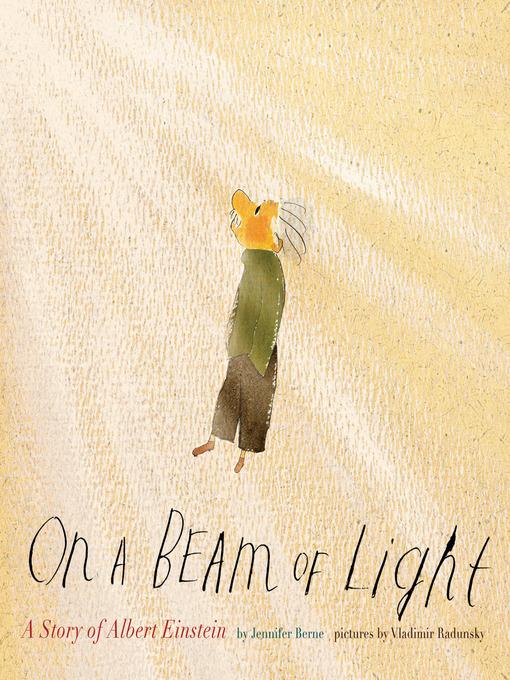
On a Beam of Light
A Story of Albert Einstein
فرمت کتاب
ebook
تاریخ انتشار
2013
Lexile Score
680
Reading Level
3
ATOS
4.5
Interest Level
K-3(LG)
نویسنده
Vladimir Radunskyناشر
Chronicle Books LLCشابک
9781452113098
کتاب های مرتبط
- اطلاعات
- نقد و بررسی
- دیدگاه کاربران
نقد و بررسی

Starred review from June 17, 2013
Berne (Manfish) and Radunsky (Hip Hop Dog) create an inspired tribute to Einstein, a man who "asked questions never asked before. Found answers never found before. And dreamed up ideas never dreamt before." The book moves briskly through Einstein's quiet, inquisitive childhood (a magnetic compass helped trigger his interest in the "mysteries in the world--hidden and silent, unknown and unseen") to his accomplishments as an adult. Radunsky's loose, hulking ink caricatures capture the gleam in Einstein's eye at every age. When Berne explains how Einstein helped prove the existence of atoms, Radunsky uses dots to underscore the idea in the accompanying image ("Even this book is made of atoms!" the scientist gleefully explains, breaking the fourth wall). Einstein's lifelong curiosity sings through every page, and Berne emphasizes that readers are heir to that same spirit of discovery. In the closing scene, Radunsky pictures a boy, girl--and dog!--wearing rather Einsteinian plaid suits, staring at a field of question marks with a familiar gleam in their eyes. Ages 6-9. Author's agent: Caryn Wiseman, Andrea Brown Literary Agency. Illustrator's agent: Brenda Bowen, Sanford J. Greenburger Associates.

Starred review from April 1, 2013
A boy who asked too many questions becomes iconic physicist Albert Einstein, whose questions changed the world. The author of Manfish (illustrated by Eric Puybaret, 2008) presents another dreamer, a man who "asked questions never asked before. / Found answers never found before. / And dreamed up ideas never dreamt before." Story and perfectly matched illustrations begin with the small boy who talked late, watched and thought, and imagined traveling through space on a light beam. Readers see the curious child growing into the man who constantly read and learned and wondered. With gouache, pen and ink, Radunsky's humorous, childlike drawings convey Einstein's personality as well as the important ideas in the text (which are set out in red letters). The narrative text includes several of Einstein's big ideas about time and space; one illustration and the back endpapers include the famous formula. The mottled, textured paper of each page reinforces the concept that everything is made of atoms. A nice touch at the end shows children who might also wonder, think and imagine dressed in the professor's plaid suit. An author's note adds a little more about the person and the scientist. For today's curious children, this intriguing and accessible blend of words and pictures will provide a splendid introduction to a man who never stopped questioning. (Picture book/biography. 6-9)
COPYRIGHT(2013) Kirkus Reviews, ALL RIGHTS RESERVED.

Starred review from April 1, 2013
Gr 2-6-The name Einstein is synonymous with genius, but what does that mean to a child? Einstein himself would only admit to being "very, very curious." Berne's picture book offers readers few biographical details, focusing instead on the physicist's intellect through the concepts that puzzled and excited him. He was late to start speaking and not particularly verbal-until he received a compass. As the author explains, "Suddenly he knew there were mysteries in the world-hidden and silent, unknown and unseen." And suddenly, too, he was bursting with questions-questions about magnetism, light, sound, gravity, and later, atoms, motion, and time. This was a person who spent his life "imagining, wondering, figuring and thinking." Radunsky's delightful pen-and-ink illustrations on cornmeal-yellow pages flecked with fibers and earth-tone highlights depict events from the man's life, his thoughts, and a few of his quirks. Einstein's old-world European childhood is reflected in the formal dress of the adults that loom over him. In an image that expresses his love of numbers, computations swirl around him. Selected lines in a large, red font add emphasis, and comments in the few dialogue bubbles are handwritten in a scratchy, black line. An endnote adds information on the physicist's thought experiments, his sense of humor, E=mc, and the atomic bomb. When considering an author's approach, Lynne Barasch's picture book Ask Albert Einstein (Farrar, 2005) and Maree Ferguson Delano's photobiography, Genius (National Geographic, 2005) are noteworthy comparisons to this richly imagined, beautifully designed, impressionistic biography.-Daryl Grabarek, School Library Journal
Copyright 2013 School Library Journal, LLC Used with permission.

Starred review from June 1, 2013
Grades 1-3 *Starred Review* It's not easy to explain the work of Albert Einstein to a young audience, but this marvelous book pulls it off. It does so by providing an overview of Einstein's life: the way he thought and how his remarkable ideas changed the way scientists think. Berne begins with baby Albert, who didn't say a word. And as he got older, he didn't say a wordbut he looked and wondered. When he was a student, his teachers thought he was too different, but his differences led him to think about natural phenomenon like light and numbers in new ways. The book reroutes the text around events in Einstein's life, such as his escape from Nazi Germany and his move to the U.S., and it only touches upon his work on the nuclear bomb. This is a more personal look, but still, it explains how he came to the discovery of atoms and his theories about the speed of light. The text could not have better support than Radunsky's artwork. Executed on textured papers, the stylized watercolors outlined in ink sometimes eschew decoration, with the focus on Einstein and others in his life; other spreads are swirled with words and numbers. The book stresses that readers may someday answer the questions that Einstein didn't get to, and an author's note extends the text with paragraphs about Einstein's pacifism, personality, and thought experiments. A book as special as its subject.(Reprinted with permission of Booklist, copyright 2013, American Library Association.)

























دیدگاه کاربران